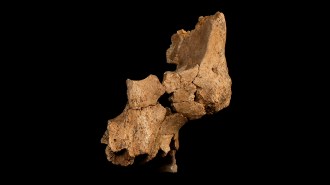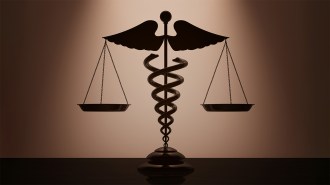All Stories
-
 Chemistry
ChemistryA new iron compound hints ‘primordial’ helium hides in Earth’s core
Earth’s core could contain helium from the early solar system. The noble gas tucks into gaps in iron crystals under high pressure and temperature.
By Skyler Ware -
 Quantum Physics
Quantum PhysicsA quantum computing milestone is immediately challenged by a supercomputer
A quantum processor solved a problem in 20 minutes that would take a supercomputer millions of years. A supercomputer then did a part of it in about 2 hours.
-
 Anthropology
AnthropologyWestern Europe’s oldest face adds new wrinkles to human evolution
Face bones unearthed in a cave suggest that members of our genus, Homo, reached northern Spain as early as 1.4 million years ago.
By Bruce Bower -
 Neuroscience
NeuroscienceParenthood may help the brain stay young
A study of nearly 38,000 adults shows that the number of kids correlates with coordination of brain regions’ activities — regardless of parents’ sex.
-
 Health & Medicine
Health & Medicine6 things to know about antidepressants
An abundance of data show that SSRIs, a class of drugs commonly used as antidepressants, are effective, though, like any drug, they have risks.
By Meghan Rosen and Laura Sanders -
 Planetary Science
Planetary ScienceUranus emits more heat than previously thought
Uranus radiates more energy than it gets from the sun, two new studies find — just as Jupiter, Saturn and Neptune do.
By Ken Croswell -
 Artificial Intelligence
Artificial IntelligenceAs AI advances, the meaning of artificial general intelligence remains murky
AI models are growing ever-more capable, accurate and impressive. The question of if they represent “general intelligence” is increasingly moot.
-
 Climate
ClimateSome trees are coping with extreme heat surprisingly well
Rising temperatures could reduce trees' ability to photosynthesize. Scientists are trying to figure out just how close we are to that point.
-
 Health & Medicine
Health & MedicineBrain implants don’t change a person’s sense of self. Hear why
In the fifth episode of The Deep End, volunteers describe what it’s like to live with the stigma of depression and the treatments they seek for it.
-
 Science & Society
Science & Society5 years after COVID-19 became a pandemic, are we ready for what’s next?
We’ve learned a lot about COVID-19 over the last five years, but big questions remain. Recent federal actions may hinder the disease’s management.
-
 Science & Society
Science & SocietyIt’s ‘personal.’ What the Stand Up for Science rally meant for attendees
Stand Up for Science rallies in Washington, D.C., and across the United States drew crowds of people worried about cuts to scientific funding.
By Meghan Rosen and Alex Viveros -
 Artificial Intelligence
Artificial IntelligenceMedical AI tools are growing, but are they being tested properly?
AI medical benchmark tests fall short because they don’t test efficiency on real tasks such as writing medical notes, experts say.
By Ananya